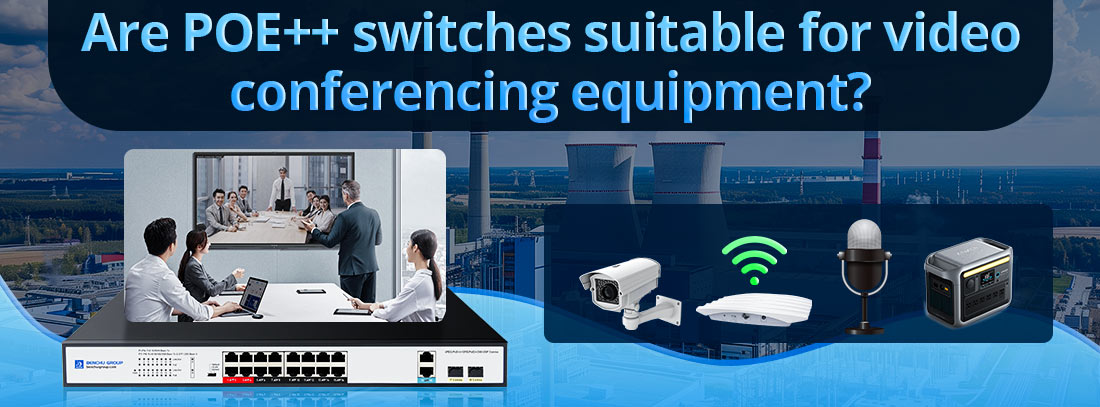
Yes, PoE++ switches are suitable for supporting video conferencing equipment, particularly in setups requiring high-power devices or centralized management. With the ability to deliver up to 100W of power per port (IEEE 802.3bt standard), PoE++ switches can efficiently power video conferencing endpoints while simultaneously providing data connectivity over a single Ethernet cable. This simplifies installation and improves reliability.
Detailed Explanation:
1. Power Requirements for Video Conferencing Equipment
Video conferencing setups typically include:
--- Cameras: High-definition (HD) or 4K cameras, especially pan-tilt-zoom (PTZ) models, often require PoE+ (up to 30W) or PoE++ (up to 60W–100W) to operate.
--- Microphones: Ceiling-mounted or table microphones generally require less power, often under 15W, which can be handled by standard PoE.
--- Displays or Digital Whiteboards: Some modern devices, like interactive displays, can require PoE++ for their higher power demands.
--- Video Conferencing Hubs: Integrated hubs or processors may need PoE++ to power their advanced processing capabilities and connected peripherals.
PoE++ switches are well-suited to handle the high power and data bandwidth demands of such devices.
2. Advantages of Using PoE++ Switches in Video Conferencing
Simplified Installation:
--- PoE++ eliminates the need for separate power outlets, making it easier to install equipment in meeting rooms, auditoriums, or remote locations.
High Power Delivery:
--- PoE++ supports power-hungry devices like 4K PTZ cameras or large conference displays, enabling seamless operation without external power supplies.
Centralized Management:
--- With managed PoE++ switches, IT teams can remotely monitor and control power allocation to devices, reducing downtime and simplifying troubleshooting.
Clean and Organized Cabling:
--- By combining power and data over a single Ethernet cable, PoE++ reduces cable clutter, creating a professional and tidy meeting environment.
3. Considerations for PoE++ in Video Conferencing Applications
When selecting a PoE++ switch for video conferencing, consider the following factors:
a. Power Budget
--- Calculate the total power required for all connected devices.
Example:
--- 2 PTZ cameras (60W each) = 120W
--- 1 interactive display (90W) = 90W
--- 4 microphones (10W each) = 40W
--- Total Power = 250W
--- Choose a PoE++ switch with a power budget that exceeds this total to ensure adequate supply.
b. Port Count
--- Ensure the switch has enough PoE++ ports to accommodate all devices.
--- Include spare ports for future expansion.
c. Data Bandwidth
--- Video conferencing equipment typically requires high bandwidth for transmitting HD or 4K video streams.
--- Choose switches with Gigabit Ethernet ports or 10-Gigabit uplinks to handle the data requirements without bottlenecks.
d. VLAN and QoS (Quality of Service) Support
--- To prioritize video conferencing traffic, select a managed PoE++ switch with:
--- VLAN support: Isolate video conferencing devices for better performance and security.
--- QoS features: Ensure low latency and jitter for video and audio streams.
e. Environmental Considerations
--- For standard office setups, a standard PoE++ switch is sufficient.
--- In larger venues, such as outdoor conference areas or industrial settings, consider industrial-grade PoE++ switches with rugged designs.
4. Key Benefits for Video Conferencing Use Cases
Reliability:
--- PoE++ switches deliver uninterrupted power, reducing the risk of device failure during important meetings.
Scalability:
--- Modern switches support adding more devices or upgrading equipment without requiring major changes to the power infrastructure.
Integration with Smart Systems:
--- PoE++ switches can integrate with other smart building systems, like lighting or environmental controls, enhancing the overall conferencing experience.
5. Example Use Cases
Corporate Meeting Rooms:
--- Power and connect PTZ cameras, tabletop microphones, and centralized control systems.
Educational Institutions:
--- Support hybrid learning setups with interactive displays, cameras, and microphones for lecture halls.
Large-Scale Conferences:
--- Ensure seamless operation of multiple devices in auditoriums or convention centers.
Conclusion:
PoE++ switches are an excellent choice for video conferencing setups due to their high power output, efficient data transmission, and support for centralized management. They simplify installation, enhance device reliability, and support advanced conferencing technologies, making them suitable for a wide range of applications in corporate, educational, and event settings. When choosing a PoE++ switch, ensure it meets your power, port, and bandwidth needs to support your current and future video conferencing requirements.